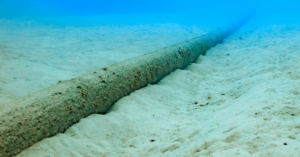
Wallenius Wilhelmsen Wins 12-Year Deal To Operate Largest Vehicle Port In Scandinavia
January 15, 2025
Cargo Ship That Hit Baltimore Bridge Completes Repairs After 10 Months
January 15, 2025

NATO has launched a new mission, named “Baltic Sentry,” to safeguard critical infrastructure in the Baltic Sea after multiple incidents of damage to undersea power and communication cables.
The initiative involves deploying frigates, maritime patrol aircraft, and naval drones to enhance surveillance and deter further threats.
The announcement was made after a summit held in Helsinki, attended by leaders from NATO member states bordering the Baltic Sea, including Denmark, Estonia, Finland, Germany, Latvia, Lithuania, Poland, and Sweden.
Recently, a series of incidents, in the Baltic Sea has contributed to the decision, including an electricity cable linking Finland and Estonia being severed in December 2024.
Finnish authorities suspect the damage was caused by the Eagle S, a tanker believed to be part of Russia’s so-called “shadow fleet.” Officials say the vessel dragged its anchor across the seabed, damaging the cable and four telecom lines.
Finnish President Alexander Stubb said that the vessel’s actions were “definitely linked to Russia.” While Finnish authorities stopped the vessel in time to prevent further damage, President Stubb said that another 12 minutes could have resulted in more severe consequences.
Mark Rutte announced that NATO’s operations would include boarding and impounding vessels deemed a threat. He discussed the importance of enforcing consequences for any harm caused to infrastructure, saying that Finland’s interception of the Eagle S tanker is a strong example of effective action.
German Chancellor Olaf Scholz supported this approach, mentioning ongoing sanctions targeting Russia’s shadow fleet and the possibility of introducing more measures against specific ships and companies.
Although Russia has not been directly accused in all cases, NATO officials suspect a pattern of sabotage linked to Moscow’s shadow fleet. Kremlin officials have denied these accusations, calling them baseless.
The damage to cables can be linked to tensions between NATO and Russia since its invasion of Ukraine in 2022. Leaders at the Helsinki summit warned of the increasing number of such incidents, with Latvian President Edgars Rinkevics urging for stronger measures.
Monitoring the Baltic Sea remains a big challenge with over 2,000 ships crossing the waters daily, NATO plans to integrate national surveillance systems and deploy advanced technologies, such as remotely operated vehicles and submarine satellites, to improve monitoring.
The new mission will also work within NATO’s Critical Undersea Infrastructure Network to collaborate with industry experts and enhance the resilience of underwater assets.
Swedish Prime Minister Ulf Kristersson cautioned against premature accusations, saying that while sabotage cannot be ruled out, the evidence must be concrete.
However, Estonian Foreign Minister Margus Tsahkna pointed out that damage to undersea infrastructure has become too frequent to be dismissed as mere accidents.
Undersea cables are essential for global connectivity, handling 95% of internet traffic and facilitating financial transactions with $10 trillion daily.
NATO Secretary General Rutte assured that the alliance would do “whatever it takes” to safeguard these essential assets.
References: Reuters, BBC
Source: Maritime Shipping News


